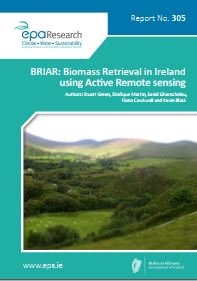Research 305: BRIAR: Biomass Retrieval in Ireland using Active Remote sensing
Authors: Stuart Green, Shafique Martin, Saeid Gharechelou, Fiona Cawkwell and Kevin Black
Summary: Hedgerows are an important feature of the Irish landscape. They perform multiple functions, acting as boundary markers, reservoirs of biodiversity, controlling run-off and they store carbon in above-ground biomass. The purpose of this study was to examine the use of an active remote sensing tool, imaging radar, to estimate biomass in hedgerows.

Hedgerows are a very significant component of the Irish landscape. They perform multiple functions, acting as boundary markers and stock-proofing fencing, supporting bio-diversity and controlling run-off. The purpose of the BRIAR (Biomass Retrieval in Ireland using Active Remote Sensing) research project was to examine the use of active remote sensing tool imaging radar to estimate biomass in
hedgerow.
Developing Solutions
High-resolution radar Earth observation data cannot be used to accurately and directly estimate hedgerow biomass because of saturation effects. A new upper limit on the extent of boundary biomass has been established and a new field approach to mapping estimates of hedgerow biomass using drones has also been developed. The study recommends that the national photogrammetric “point cloud” from the Ordnance Survey be used as a basis for a national inventory modelled on existing county field surveys in order to accurately measure hedgerow volume and thus above-ground carbon storage.
https://www.epa.ie/media/epa-2020/publications/research/Research_305_thumbnail[1].jpg